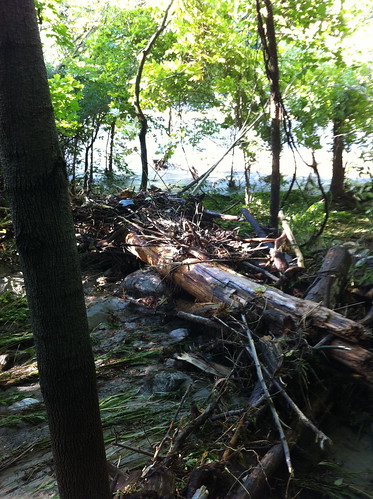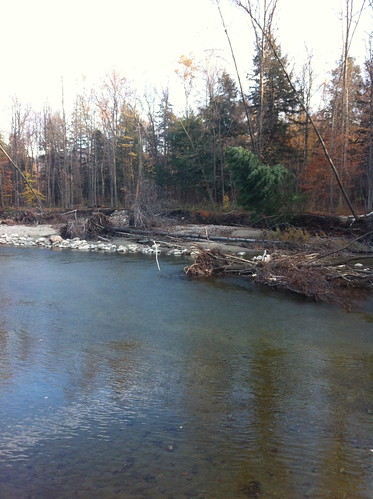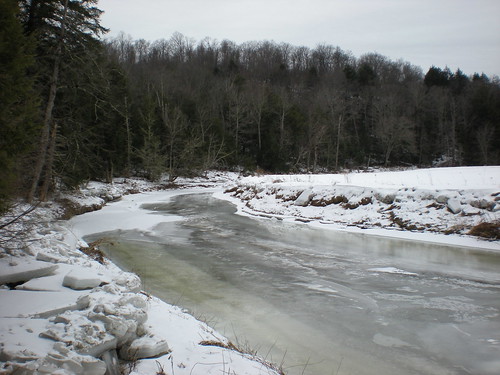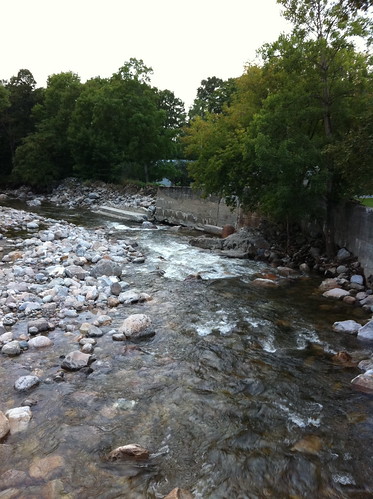
Scenes like the one above are now common in Vermont, and are particularly common along the Middlebury River near where I live. Some are glad to see the logs in the river - they can provide habitat for various animals, including trout and the species they eat. Others are concerned that the logs in the river could cause future problems - causing ice jams or collecting under bridges and causing washouts.
So, who's 'right'?
Well, I will start out with my normal disclaimer. Rivers are very complex, and when they flow through human occupied areas, normal river phenomena such as shifting channels become disasters, even though these events are actually beneficial when in an intact flood plain away from people. It's very hard for even an expert to predict future river conditions, and I'm not making any 'official' recommendations to anyone. However, I can share my observations as well as thoughts expressed by others with knowledge in the subject.
There's no doubt that tree trunks and other debris in a river during a flood can sometimes add to damage to structures. I've witnessed quite a few floods, and watched debris of all sorts hurtling down a river channel. What I am uncertain of is how much relative risk preexisting logs in the river pose to structures. Any flood of significant size will bring many trees falling into a Vermont river. By the time the next flood comes, some of the logs currently in the river will hopefully be quite rotten... it seems that new trees falling into the river cause the greatest risk. However, there's no way of keeping lots out of the river short of deforesting riverbanks, which would cause much, much more trouble than it would solve.

In some cases, as above, woody debris was deposited in the flood plain. These logs will decompose, add to the soil in the area, and nurture the trees still standing along the river. Since these trees offer flood control, this already-rotting debris is an asset, not a liability.
But what about when an extreme flood like Irene creates extreme conditions - dams of flood debris that threaten to shift the course of the river and endanger structures? Such a situation occurred in East Middlebury after Irene when a log jam was said to be part of the reason the river backed up and flooded down East Main Street. I didn't get a chance to see this log jam... because it was quickly removed... but it seems reasonable that in that sort of situation debris may need to be removed from the river.
There has been calls to continue work downstream, and remove more logs and debris from the Middlebury River upstream from Route 7. I've walked this section of river, and I have noticed quite a few downed logs, but not any that seem to be creating a dam or a risk for diverting water into populated areas. It's possible that such conditions exist somewhere and I did not see them, but I'm quite reluctant to say that removing downed trees will increase flood safety. In fact, removal of some trees would reduce flood safety:

The trees above are wedged up against a bank where erosion is occurring. The trees, especially their tangled root balls, appear to be REDUCING erosion. If these trees were dug out of the slope and removed, the result could be heavy erosion.

These trees are mostly stuck in a sand bar, which they seem to be helping stabilize.
There's also understandable concern about ice jams.

Above is Lewis Creek, with a solid ice cover, two winters ago. Ice jams occur when ice like this breaks up and collects near obstructions in the river (or when newly-forming ice does the same thing). They can cause sudden, dramatic flooding of frigid water filled with blocks of hard, heavy ice. Ice jams can be terrifying, and we want to do everything we can to avoid them. I'm not an expert on ice jams, but I didn't see any logs in the river that seemed to be at risk of causing an ice jam. There is probably a risk of ice jams at the Highway 7 bridge but honestly, having seen one ice jam and the aftermath of a second... it appears that ice jams completely shred logs, and the real danger is mainly posed by the ice. The best way to avoid ice jams is by building bridges with lots of room under them, and by doing a good job of maintaining flood walls and levees, like the one below (which has been partially repaired since Irene but needs more work!)

My biggest concern about tree removal in the Middlebury River does not stem from removal of the trees, but rather access to the river. It's highly unlikely that the city will have access to a helicopter to remove the debris, so removal would require driving heavy machinery into the river, a process which could cause disturbance and thus erosion to river banks. At this point I am skeptical that removal of logs from the Middlebury River in East Middlebury will provide more benefit than detriment, though I'm certainly open to listening to anyone who disagrees (and already have done so, and have learned quite a bit about the river in the process.) There are, however some cases where debris such as bent culverts, garbage and pieces of broken road and structures are in the river, and if there is a non-destructive way to get these out, it would be a good idea.
What about sustainably harvesting downed wood to use for heating, construction, or other tasks? It's a valid point, and hopefully the debris that was already removed was used for something of that sort. By now, however, I'd imagine most of the logs that have been sitting in the river or are half buried in wet sand aren't going to be terribly useful as firewood or for construction. If any trees are removed that are still in good enough shape for these uses, I'm all for it.
Not to sound like a broken record here... but the main flood risks to Vermont communities aren't logs in the river or the cessation of gravel removal. The main flood risks are caused by poor conditions in upper watersheds, loss of wetlands and flood plains to slow down floodwaters, improperly built bridges, improperly placed structures, and poorly maintained (or non-maintained) flood control structures. In the end, ignoring or removing the logs in the Middlebury River won't be what determines how bad the next flood is... that will be determined instead by how we treat the river and watershed as a whole. Hopefully we now make good decisions, so that the next flood is less destructive than Irene.

No comments:
Post a Comment